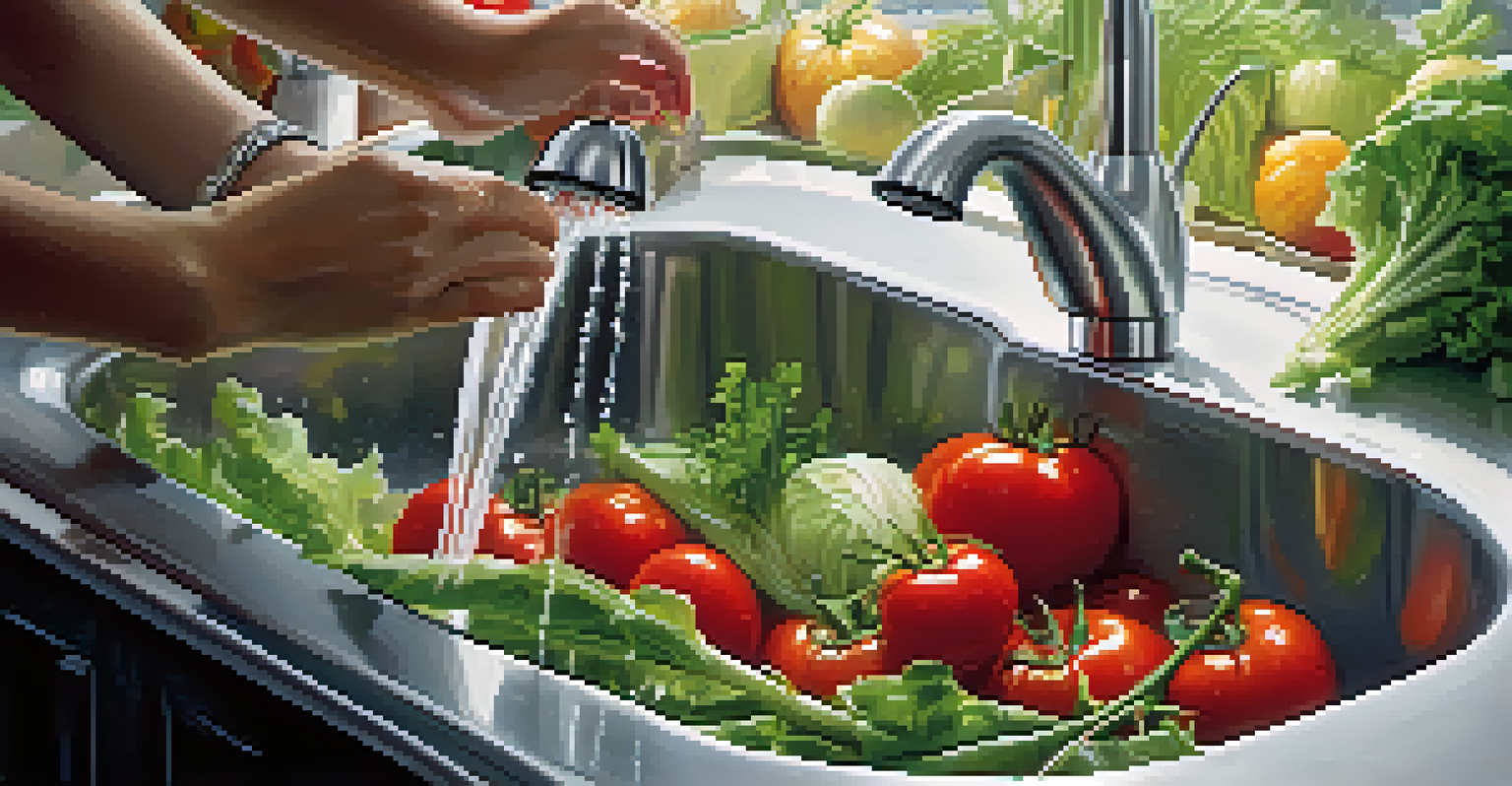Health Risks: Understanding Raw Foods and Food Safety Issues

Understanding Raw Foods: Benefits and Risks
Raw foods, including fruits, vegetables, nuts, and seeds, are often praised for their nutritional benefits. They are rich in vitamins, minerals, and enzymes that can boost health and overall well-being. However, consuming raw foods also presents certain risks that must be acknowledged.
Let food be thy medicine and medicine be thy food.
One of the primary risks associated with raw foods is the potential for foodborne illnesses. Foods such as raw sprouts, unpasteurized juices, and raw meats can harbor harmful bacteria like Salmonella or E. coli. These pathogens can lead to serious health issues, particularly for vulnerable populations such as children, pregnant women, and the elderly.
To enjoy the benefits of raw foods while minimizing risks, it's essential to understand how to properly handle and prepare them. This includes washing fruits and vegetables thoroughly, being cautious with sources of raw animal products, and practicing good hygiene in the kitchen.
Common Pathogens in Raw Foods: What to Watch For
Certain pathogens are frequently found in raw foods, making awareness crucial for food safety. For example, raw eggs may contain Salmonella, while leafy greens can be a source of E. coli. Knowing which foods pose the highest risk can help you make informed choices.

Additionally, unpasteurized dairy products can be breeding grounds for Listeria and Campylobacter, which can lead to severe illness. It's important to check labels and choose pasteurized options whenever possible to reduce the risk of exposure.
Raw Foods Offer Nutritional Benefits
Raw foods like fruits and vegetables are packed with essential vitamins and minerals that can enhance overall health.
Cooking food to the proper temperature kills harmful bacteria, but if you're opting for raw foods, consider using organic products from reputable sources. This can significantly lower your chances of encountering harmful pathogens.
The Importance of Food Hygiene in Raw Food Prep
When preparing raw foods, practicing good food hygiene is non-negotiable. Begin by washing your hands thoroughly before handling any food. This simple step can dramatically reduce the risk of transferring harmful bacteria from your hands to your meal.
You are what you eat, so don't be fast, cheap, easy, or fake.
Next, ensure that all surfaces, utensils, and cutting boards are clean and sanitized. Cross-contamination is a common concern, especially when preparing raw meats alongside fruits and vegetables. Using separate cutting boards for different food types can help maintain safety.
Finally, store raw foods at the correct temperatures to inhibit bacterial growth. Refrigerate perishable items promptly and avoid leaving raw foods out at room temperature for extended periods.
Identifying High-Risk Raw Foods to Avoid
Some raw foods carry a higher risk of foodborne illness than others. For instance, raw seafood, such as oysters and sushi, can be particularly risky due to the potential presence of Vibrio bacteria. It's crucial to know which foods are considered high-risk to make safe choices.
Another high-risk category includes raw sprouts like alfalfa and mung beans, which can easily become contaminated during growth. Even organic varieties are not immune, so it's wise to cook these before consumption if you're concerned about safety.
Food Safety is Crucial with Raw Foods
Understanding the risks of foodborne illnesses and practicing proper hygiene when handling raw foods is essential for safety.
If you’re unsure about the safety of certain raw foods, it’s best to err on the side of caution. Cooking food not only enhances its flavor but also ensures that any harmful microorganisms are eliminated.
Nutritional Considerations: Cooking vs. Raw
One of the debates surrounding raw foods is the nutritional value compared to cooked options. Cooking can enhance the bioavailability of certain nutrients, like lycopene in tomatoes, making them easier for your body to absorb. However, some nutrients, particularly vitamin C and certain B vitamins, can be lost during cooking.
Balancing raw and cooked foods in your diet is a smart approach. For example, enjoy salads with fresh vegetables while also incorporating cooked dishes that offer additional nutritional benefits. This way, you can enjoy the best of both worlds.
Ultimately, the key is to listen to your body and how it responds to different food preparations. Some people thrive on a raw food diet, while others may experience digestive issues or nutrient deficiencies when eliminating cooked foods entirely.
Debunking Myths: Raw Foods and Food Safety
There are many misconceptions about raw foods that can lead to unsafe practices. One common myth is that all raw foods are inherently healthier than cooked ones. While raw foods can be nutritious, they also require careful handling to avoid foodborne illnesses.
Another myth is that washing raw produce is unnecessary. In reality, even organic fruits and vegetables should be washed thoroughly to remove dirt, pesticides, and potential pathogens. A gentle scrub under running water can make a significant difference.
Balance Raw and Cooked Foods
Incorporating both raw and cooked foods in your diet can provide a wider range of nutrients and health benefits.
Understanding these myths and the truth behind them can help create a safer eating environment. Always prioritize food safety, no matter how healthy a raw food may seem.
Taking Action: Safe Practices for Raw Food Consumption
To enjoy raw foods safely, start by sourcing them from reputable suppliers. Look for local farmers' markets or grocery stores known for high-quality produce. This not only supports your community but often guarantees fresher and safer options.
It's also helpful to stay informed about food recalls and safety alerts. Monitoring resources like the FDA's website can provide timely updates on any potential hazards related to raw foods you may consume.

Finally, trust your instincts. If something doesn’t look or smell right, it’s better to err on the side of caution. Food safety is all about making informed decisions to protect your health and well-being.